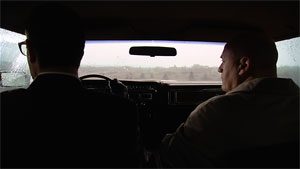David Claerbout | Panorama’s
American Car, 2005, video installation
Entering the space, the viewer comes across a familiar image ostensibly extracted from a thriller: two men are seen from behind, sitting in an American car, looking at something outside the frame, with the engine running. The pouring rain outside the car blocks one’s field of vision, preventing clues as to the men’s identity, the object of their gaze, or the setting in which they sit in wait. While in Hollywood films this familiar situation of tailing or anticipation usually leads to a climax, here the anticipation remains unsatisfied.
Beyond the wall dividing the space the viewer encounters a second projection: the same American car, this time seen from a distance. Unlike what we may have expected, however, it is not parked in an urban street, but rather at the heart of a classical American landscape. The spectacular scenery is photographed one minute after the rain stopped, with only the passing clouds and chirping birds indicating that this is a video projection rather than a static slide projection.
Moving from the first to the second space, the viewer finds himself standing at the spot where the gazes of the men in the car are turned. In the transition from one room to another he transforms from observer to observed, in fact functioning as the object of his own gaze and an active participant in the scene evolving between the two screens. The temporal and spatial leaps in the transition between rooms undermine the unity of time and place, yet generate a sense of cinematic credibility, as the viewer’s movement and gaze produce the narrative, lending meaning – albeit open and obscure – to the two dissociated scenes.
